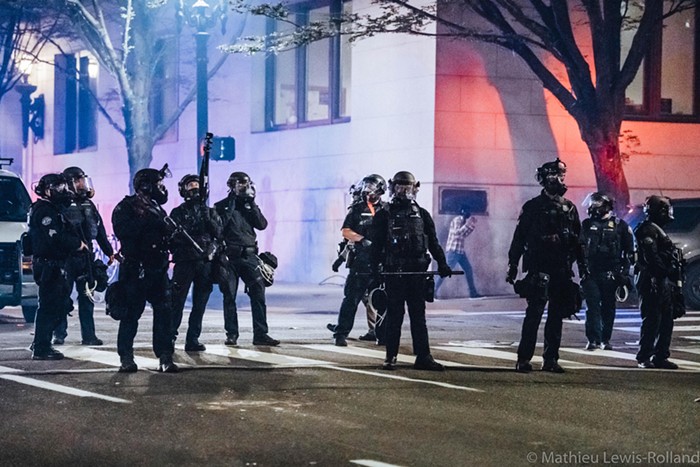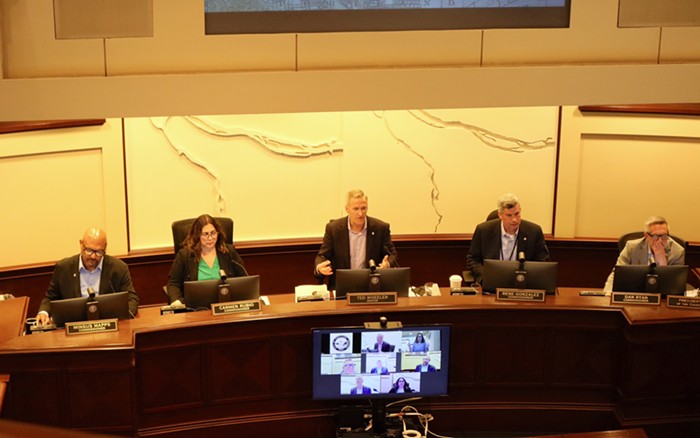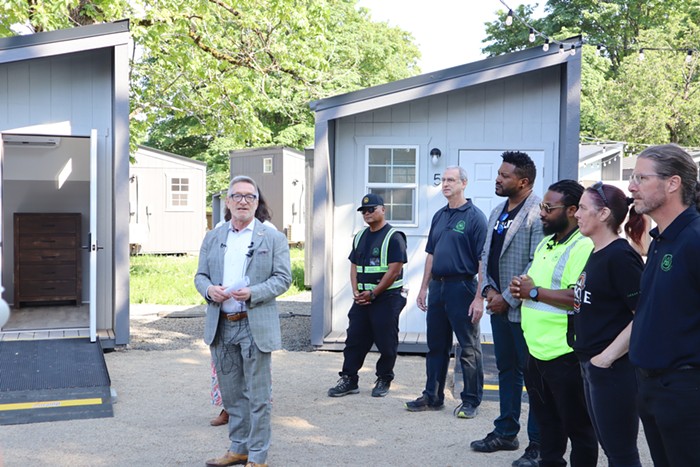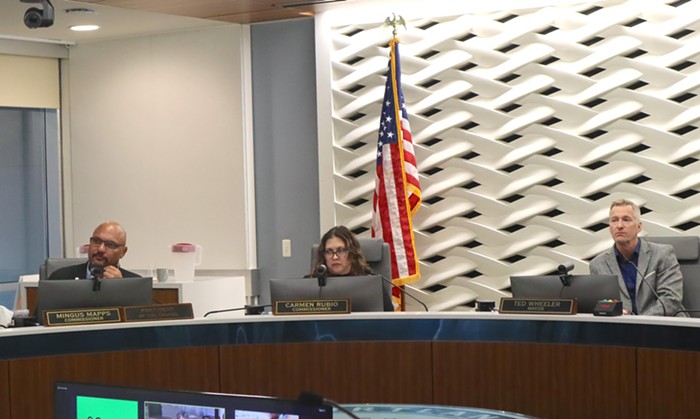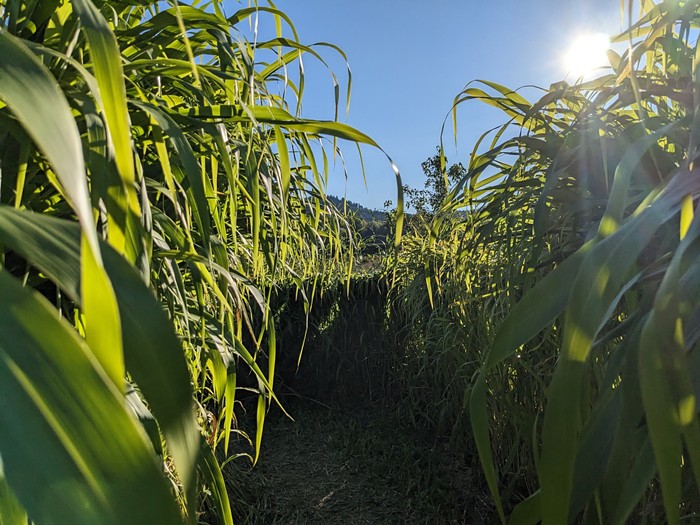
Every time a Portland officer uses force against a member of the public—whether it's shooting someone with a firearm or roughly forcing them into handcuffs—that officer is required to file a report detailing the force and explaining its necessity. Per the Portland Police Bureau's (PPB) policy on this requirement, this report must be filled out before an officer's shift ends. That officer's supervisor is then required to review the report and analyze whether or not it met PPB's guidelines within 72 hours.
During last summer's protests, where PPB officers regularly blanketed crowds in clouds of tear gas, fired so-called "less lethal" weapons at people's heads, and shoved people who didn't immediately follow dispersal orders, these reports were rarely filed on time—and when they were, lacked "little or no critical assessment," according to a February report by the US Department of Justice (DOJ). In total, PPB estimates its officers used force more than 6,000 times against people during the 2020 protests.
The city maintains, however, that police officers' inability to keep up with the pace of their own actions during these protests isn't their fault.
During a Tuesday public meeting on police oversight, a city representative instead placed the blame on the unexpected surge of consecutive protests against police violence and racial inequities, arguing that PPB shouldn't have been expected to meet its own standards under such conditions.
"It is our position that we were overwhelmed by the situation that we faced through the summer in the unprecedented protest activity that took place in this city," said Mary Claire Buckley, the city employee who oversees PPB's Office of the Inspector General, which reviews use of force reports. "No other city in this country had 171 straight days of protest activity."
Buckley's explanation suggests that Portland police had no option but to use unusually high amounts of force against the public during the largely peaceful demonstrations. This excuse doesn't sit well with DOJ attorneys who are tasked with monitoring PPB's ability to follow its own use of force rules.
"If the system can’t handle the amount of force that the city chooses to use during the crowd control situation... that’s a problem."
"If the system can’t handle the amount of force that the city chooses to use during the crowd control situation," said Jared Hager, an assistant US attorney for the DOJ, speaking at the Tuesday meeting, "well... that’s a problem that we’re now confronted with."
Hager and other US attorneys have spent the past seven years reviewing the PPB's use of force protocols as part of a 2014 court-approved settlement agreement between the DOJ and the City of Portland. The agreement followed a 2012 federal investigation which found that Portland police had a practice of using excessive force against people with a mental illness. The settlement agreement hoped to resolve this civil rights issue by introducing new accountability measures within PPB, including the policy requiring officers to report use of force incidents by the end of their work shift.
In January 2020, the DOJ announced that the city had finally met all the requirements of the settlement agreement. Before being officially released from the settlement, however, the city had to continue meeting those requirement for one full year. Then the protests began. Last month, the DOJ reported that the city had fallen out of compliance with the agreement, largely due to the way police handled 2020's demonstrations.
In the February report, the DOJ said police officers' use of force reports and their supervisors' required analysis of these reports, "showed a varied level of critical analysis of force decision making."
"Validation of individual uses of force with little or no discussion of reasonableness of the force used or of de-escalation attempts, stands in contrast to PPB’s policy requirements for force investigations," the report read.
DOJ attorneys went over this report during the Tuesday meeting of the Portland Committee on Community-Engaged Policing (PCCEP), a citizen oversight group responsible for reviewing whether police are following the settlement agreement.
"Over the summer it was revealed to the city, community, and the world, really, that there is a systemic failure to implement some of the terms of the settlement agreement," said Hager.
He said this failure points to bigger problems within the PPB's system that reviews use of force—problems that the DOJ had previously missed in its annual reviews.
"Just because there was 6,000 uses of force doesn’t mean that that it was unconstitutional force... or anything wrong with the force, I would remind you."
There are a few ways an officer can be investigated for use of force: A member of the public who was the subject of an officer's force can file a complaint against that cop with the Independent Police Review (IPR) office, a PPB employee can file a complaint against a fellow officer with PPB's Internal Affairs office, or an analyst in the Office of Inspector General—which regularly audits use of force reports—can call for IPR to investigate an incident that seems to violate PPB use of force policy.
This last option could be complicated, however, if officers' use of force reports are delayed and include scant information or analysis about their actions—which is how the DOJ described most reports filed during the 2020 protests.
At the Tuesday meeting, DOJ attorney Jonas Geissler said this deficiency leaves IPR, the city's current police accountability arm, unable to truly hold police accountable for inappropriate use of force.
"Having failed the system's investigation of force on the front end," said Geissler, "you starve the accountability system on the back end of necessary data to understand whether or not the force is constitutional."
Buckley, with the Office of Inspector General, didn't specifically address the lacking data in the delayed force reports. But she pushed back at the suggestion that the city's system for investigating force was broken.
"It was not that the bureau didn’t have a system, it wasn’t that we didn’t do the work, it was that there was so much of it we couldn’t keep up," said Buckley. "Just because there was 6,000 uses of force doesn’t mean that that it was unconstitutional force... or anything wrong with the force, I would remind you."
It's unknown how many of the 6,000 cases were flagged for further investigation by Buckley's office, let alone how many were determined to be unconstitutional.
Hager maintained that, if Portland police want to use a lot of force against the public, it's on PPB to be prepared to collect, analyze, and investigate that force in a timely fashion. He said the DOJ has now asked the city to explain how they plan on improving their ability to report and analyze officers' use of force to again meet the terms of the settlement agreement.
According to Buckley, the city is under no obligation to provide the DOJ with such a plan. While PPB will undergo crowd control training to address the problems underscored in the DOJ's latest report, she said they won't be providing the DOJ with a formal remediation plan because the city hasn't done so in the past.
If this stalemate persists, Hager said the DOJ may be forced to issue a notice of non-compliance under the settlement agreement to the city, forcing both sides to meet before a federal judge to determine some fix. It would be the first time the DOJ would issue such a notice in the history of the settlement agreement.
Geissler said the DOJ is "eager" to see the city acknowledge two issues, one being the lack of data collected during the use of force reports.
"The second issue is the willingness to hold people to account," he said. "Absent that, I don’t know where we go from here. We’ll have to see."

